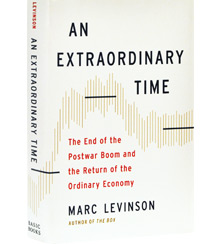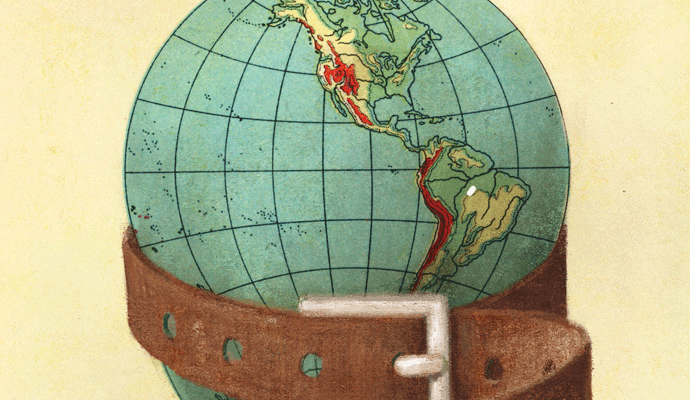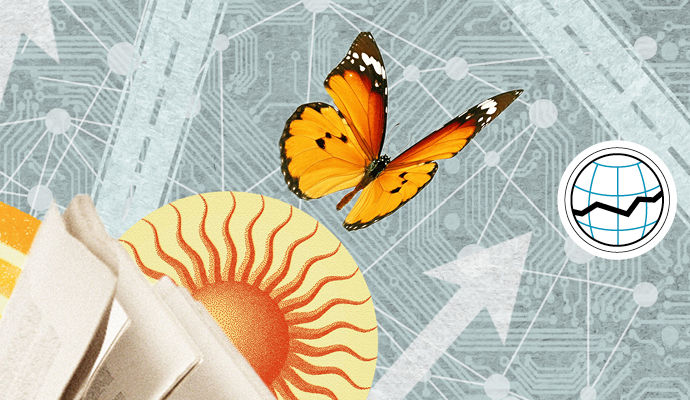Best Business Books 2017: Economics
Not-So-Great Expectations
Marc Levinson
An Extraordinary Time: The End of the Postwar Boom and the Return of the Ordinary Economy (Basic Books, 2016)
Rick Wartzman
The End of Loyalty: The Rise and Fall of Good Jobs in America (PublicAffairs, 2017)
Walter Scheidel
The Great Leveler: Violence and the History of Inequality from the Stone Age to the Twenty-First Century (Princeton University Press, 2017)
*A TOP SHELF PICK
Invariably, the stories return to World War II. Ten years after the first stirrings of the global financial crisis of 2007–09, economic historians are trying desperately to understand what has gone wrong. With remarkable frequency, writers and thinkers orient themselves and their stories around World War II, which seems entirely appropriate: What’s happening in the global economy and in politics certainly may feel like an unraveling of the postwar institutions and order. But precisely why that unraveling is occurring and what it implies for the future is a matter of debate. This year’s three best business books on economics focus on this issue. They vary in their pessimism.
Marc Levinson, author of An Extraordinary Time: The End of the Postwar Boom and the Return of the Ordinary Economy, is not very hopeful. But neither does he suggest that something has broken. Levinson is a historian and journalist, formerly of the Economist (and an occasional contributor to s+b), who is best known for The Box, a surprisingly engrossing history of container shipping. An Extraordinary Time, like The Box, is an efficiently presented chronology of the global economy since the end of World War II. Levinson opens at the hinge of this chronology, which he locates in October 1973 — at the start of the oil crisis precipitated by the Yom Kippur War. In Levinson’s telling, this single moment split the postwar era into the decades of freakishly rapid and broad-based growth and the subsequent period of uneven and unequal progress.
An Extraordinary Time reminds us just how tenuous were conditions after the surrender of Nazi Germany and Imperial Japan. With much of the world in rubble, both victors and defeated nations lacked the hard currency to import basic essentials, to say nothing of the material needed to rebuild. Economists worried, or assumed, that demobilization would plunge industrialized economies back into a depression. Even rich economies remained a long way from what we would consider modernity. In 1948, Levinson reminds us, only one French household in 30 had a refrigerator.
But then came three decades of extraordinary growth — Les Trente Glorieuses in French, Wirtschaftswunder in German, and the Japanese postwar “economic miracle” — that utterly transformed the lives of many Europeans and East Asians. Families who worried about finding their next meal in the 1930s, and who fled for their lives during the war, suddenly found themselves with telephones, televisions, automobiles, and well-stocked fridges to boot. Prosperity brought confidence in government and a feeling of security, even in the shadow of the Cold War.
As Levinson traces the era’s macroeconomic history, it is clear that in the 1970s, this era came to an end — slowly and then all at once. Weaving together data and narrative, he shows how productivity growth foundered and the irritant of inflation appeared and would not leave. The social strains that began to simmer in the 1960s boiled over, politics turned more dysfunctional, and the economic themes that would dominate the next few decades (rising inequality, wage stagnation, and financial instability) began to emerge. Faith in the competence and honesty of government was shaken. During the boom years, rapid growth had flattered nearly every intervention, making even the most ham-handed central bankers and trade officials seem like policy geniuses. But in the 1970s, what had worked before suddenly didn’t. Stimulus programs raised inflation but did nothing to reduce unemployment. Industrial policy no longer seemed a reliable route to higher productivity.
Yet as Levinson notes, this sudden helplessness did not cause an outbreak of humility. In fact, another set of wonks seized their chance to slash tax rates and regulation, privatize state-owned businesses, and squeeze union power. Perhaps economies would have performed worse in the absence of such measures. But the change of tack did not prevent inequality in the distribution of economic gains even as growth in incomes and productivity remained well short of the postwar glory days.
That should come as no surprise, argues Levinson. In his macro view, the golden age was an aberration. In the decades prior to it, technological innovations such as electricity and automation piled up unused by the private sector thanks to the Great Depression and war. The conflict also repressed corporate investment and consumption. Then after the war, a burst of investment in productive capacity, infrastructure, and education juiced employment and incomes, and generous government benefits powered consumer demand. As governments worked to piece the global trading and financial system back together, integration further propelled growth. Rarely in history has so much economic potential been unleashed at a stroke.
But since the 1970s, the circle has unwound. People grew less secure as their incomes oddly failed to soar, and as social safety nets began to fray. There was nothing nefarious behind all this, in Levinson’s view. It simply represents regression to the mean. And there’s no easy fix, apart from an adjustment to our expectations. Although Levinson correctly points out the fundamental difference in growth potential between the early postwar period and more recent decades, he is too willing to accept that things could not have gone better for most people since the early 1970s — and that actions taken by politicians and business leaders were ineffectual.
The Decline of Paternalism
Rick Wartzman provides a less fatalistic account of the same story in The End of Loyalty: The Rise and Fall of Good Jobs in America. Wartzman’s book is a meticulous and essential history of the worker’s place in the postwar corporate United States. He, too, starts his narrative arc during World War II, as titans of industry met to work out how to employ all those who would need jobs at the war’s end. Having come through the pain of the Depression and the sacrifice of the conflict, residents were desperate for security. If the economy could not deliver — if its corporate giants could not provide — there would be no telling what sort of political backlash the capitalists would face in the home of capitalism. In the words of Harrison Jones, then chairman of Coca-Cola, “Any nation with a great unemployment wave becomes a seedbed for -isms.”
Wartzman is also a journalist, and a director at the Drucker Institute. His comprehensive tale follows four of the great companies of the 20th century — General Electric, General Motors, Kodak, and Coca-Cola — all of whose executives were members of the conspiracy to maintain full employment. In the decades before the war, they had not been uniformly progressive or paternalistic. At Kodak, generous pay and benefits were meant to foster loyalty, but also to deter efforts to unionize. General Motors, having hired Pinkerton detectives to spy on and thwart efforts to organize its plants, ultimately acquiesced to union pressure in the 1930s, but only after the Wagner Act made organizing far easier.
After the war, as unions gained more strength and critical mass, GM and the United Auto Workers struck the so-called Treaty of Detroit in 1950, which established a model for the achievement of labor peace. The five-year contract protected GM (and later, other carmakers) from the risk of strikes, while workers received good pay, annual cost-of-living adjustments (which became a common feature of labor contracts), and a pension. It also established a set of benchmarks that other industrialized companies would follow.
As the decade wore on, the benefits that were extended to workers grew. Some employees received annual “wage dividends” as a form of profit sharing. Pensions and health benefits expanded, as did efforts to shield employees from turns in the business cycle. Firms invested heavily in workforce training, occasionally setting up internal institutes indistinguishable from university programs. Companies pumped out a steady stream of consumer goods to soak up fattening paychecks and fill the homes employees were buying in growing numbers. It worked for everybody in the U.S. — workers, management, shareholders — in part because so much of the world’s productive capacity had been destroyed in the 1940s and was slow to rebuild.
Wartzman concludes, as does Levinson, that the good times could not continue. But the story he tells is more specific to companies and industries. As the world’s other rich economies recovered, the competitive environment for firms intensified. GM, for example, faced competition not just from Ford and Chrysler, but from Toyota and Honda. Improving technology allowed manufacturers to automate factory floors and streamline corporate offices. The macroeconomic environment also grew more difficult. Cost-of-living adjustments and union wage bargains were increasingly seen as the source of inflationary pressure, and therefore something to be resisted. Companies relocated their operations from the Midwest and Northeast to Southern states, where labor costs were lower and organized labor nonexistent.
For Wartzman, the new generation of post-1970s policymakers that Levinson focuses on had a parallel in the executive suite. CEOs began to prioritize profits and share prices over commitments to employees, and hacked away at fat payrolls. “Any organization that thinks it can guarantee job security is going down a dead end,” said Jack Welch, the iconic General Electric CEO who earned the sobriquet Neutron Jack. “Only satisfied customers can give people job security.” Complacent companies were at risk of experiencing an assault by corporate raiders. Ronald Reagan’s decision to break the air traffic controllers’ strike in 1981 represented a stark warning to organized labor: Submit or face destruction. Even left-leaning politicians embraced the notion that the computing age demanded flexibility and the relentless accumulation of skills.
As the Treaty of Detroit was metaphorically ripped up in the decades after the 1970s, the sense of corporations’ loyalty to workers was utterly destroyed. Yet Wartzman presents this broad and important shift as the inevitable result of structural economic change: of technological advances, globalization, and the increased pace of change across markets. Where Levinson casts the difficulties of workers as the result of regression to the mean, Wartzman suggests they are the product of adaptation in the face of progress. And it is indeed difficult to imagine that GM and Kodak, whose size and history could not prevent a spiral into bankruptcy, could have maintained their historical commitments and loyalty to workers and still prospered. Nonetheless, Wartzman, along with Levinson, doesn’t fully examine or explain how the intentional economic reforms of the 1970s and 1980s altered the political climate in which these companies operated.
Mean Means
In the year’s best and most striking economics book, Walter Scheidel views today’s economic woes through a significantly wider — and darker — lens. The Great Leveler: Violence and the History of Inequality from the Stone Age to the Twenty-First Century is a more sweeping, bleaker version of Thomas Piketty’s Capital in the Twenty-First Century. A professor of history at Stanford University, Scheidel packs the book full of data and historical analysis, including differences in the comparative splendor of ancient tombs and variances in human height, to present a stylized but compelling picture of inequality across the whole of human history. Inevitably, he argues, societies that manage to create an economic surplus become economically and politically unequal. Within those societies, over time, elites get better and better at rigging the system to divert resources toward themselves. Only catastrophe limits the march toward greater inequality — great plagues, state failure, revolution, and mass-mobilization warfare.
Only catastrophe limits the march toward greater inequality — great plagues, state failure, revolution, and mass-mobilization warfare.
In Scheidel’s view, this has been the way of things since the domestication of crops more than 10,000 years ago. Farming societies generated agricultural surpluses, and found themselves with land, equipment, and stores of food that needed defending. Such societies sorted themselves into hierarchies dominated by the strong, who were best able to defend the surplus — or to expropriate an outsized share of it. Control of resources made elites stronger still, and allowed them to bend the rules of society in their own favor.
Political and economic inequality carried on growing in this way until disaster struck. In the West, for example, inequality reached a peak under the Romans, when a large and integrated Mediterranean market generated enormous wealth that flowed in wildly disproportionate degree to elites. State collapse destroyed that market and led to a dramatic fall in inequality that persisted for centuries. But over time, medieval European elites built new states, restored commerce, and established tighter control, driving a renewed upward trend in inequality. That, then, was interrupted by the arrival of the plague in the 13th and 14th centuries. Mass death resulted in a scarcity of labor, which returned power to the surviving peasantry. But when the population began to recover, inequality began to rise — straight through the ages of colonialism and industrialization and right up to the eye-popping levels of 1914, when both revolution and mass-mobilization warfare were unleashed.
World War II was a historically potent leveler of economic status. In the thick of war, governments seized corporate elites’ power to run the economy and drained corporate fortunes to fund the war machine. Much of what was left was shattered by inflation and physical loss. In defeated and victorious nations alike, the social trauma of war and the political demand for new rules and institutions that would make its recurrence less likely led to sweeping changes in the state’s role in the economy, such as the creation of the welfare state, which enshrined in law the regular redistribution of resources from rich to poor.
And then, many of us imagined, history ended, more or less. The welfare state and international institutions such as the European Union and GATT made the world safe for global capitalism, which eradicated the threat from communism, brought magical technologies into the world, and finally spurred development in the world’s vast emerging markets. But, as Scheidel notes, even as communism was teetering and triumphalism was spreading, the old worrying trends emerged: slow productivity growth, stagnant incomes, and rising inequality. Why?
Perhaps, as Levinson writes, it was simply a matter of regression to the mean. Or perhaps, as Wartzman reckons, it reflected the ways in which the world was becoming a more complicated place with new markets and technologies and realities to manage, demanding new expectations and ways of doing things. But Scheidel’s work suggests a different interpretation. Perhaps what we have seen is the reestablishment of an even older pattern. Maybe the tax cuts and the deregulation, the union busting and the trade deals, the waning interest in public investments and the listless response to regional economic hardship, the complacency toward the financialization of the global economy and concentration of economic power in the hands of a few firms — maybe all of that was, at least in part, the doing of elites who wanted a larger pie, yes, but also a larger share of it. And perhaps they are not done with their work.
Of course, Scheidel’s bleak theory need not be prophecy. He, like Thomas Malthus, may have identified a fundamental truth about the world just as it ceased to apply. But saving liberal society and the market economy will require quite a lot of political effort. These books, with their compelling diagnoses, tell us that we are recognizing the seriousness of the problem. They also make clear that we are a long way from agreeing about how to treat it.
Reprint No. 17413
Author profile:
- Ryan Avent is economics columnist at the Economist. He is the author of The Wealth of Humans: Work, Power, and Status in the 21st Century (St. Martin’s Press, 2016).








